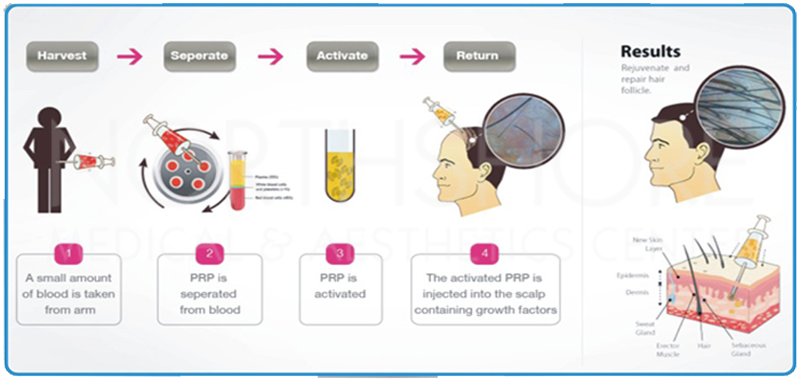
PRP + A-Cell for Hair Restoration
At the Northshore Medical & Aesthetics Center, we have been performing PRP therapy as a proactive therapeutic option for male and female patients experiencing hair loss. PRP is an exciting non-surgical therapeutic option for patients who require stimulation of hair growth for hair loss conditions.
Recent scientific research and technology provides the medical community with new understandings of wound and tissue healing. As a result of these scientific studies, we know PRP is an all-natural medical procedure performed in physicians offices for hair loss or conditions causing hair thinning. In a recent study published in Dermatologic Surgery, physicians in Korea published data supporting the clinical application of PRP in hair restoration.
How does PRP work?
Human blood contains mesenchymal stem cells and autologous blood products that contain essential and specific growth factors that assist in tissue regeneration and healing. Published medical literature from Europe and the United States confirms the safety and use of PRP therapy. PRP therapy has established itself to be effective as a medical treatment modality in the specialty fields of oral surgery, neurosurgery, plastic and cosmetic surgery, sports medicine and orthopedics. It has been used extensively in these specialties for the last two decades with generally positive outcomes and success. In the field of hair restoration, existing evidence demonstrates PRP therapy as a promising treatment option to promote hair growth.
While PRP is in the early stages of scientific research in hair restoration, PRP is not meant to replace current FDA approved therapies such as DHT blockers and Minoxidil. but it is a promising non-surgical therapeutic option for those patients with hair loss.

How do you perform the Procedure?
Blood is drawn in our office as though you are having routine blood testing at your primary care physician's office. The blood is spun in a centrifuge and the PRP is separated and removed from the rest of the blood.
The PRP is taken from your body and is specially prepared by spinning down the blood cells to a high concentration. After centrifugation, the platelets and other vital growth proteins raise to the top of the tube. Under a topical anesthesia, a special micro needling roller device is used to stimulate the dermis of the scalp. This micro needling stimulation causes microtrauma to the dermis that induces other healing and growth repair cells into action. The highly concentrated platelet rich plasma (PRP) is then injected into the scalp and topically.
The PRP contains many growth factors that stimulate the hair follicle's growth. PRP can be used preoperatively, intraoperatively, or post operatively. Some patient's chose to have PRP performed every three (3) to four (4) months as early data suggests regular or semiannual PRP treatments can stimulate hair growth.
The Science Of PRP
PRP contains special cells called Platelets, that can cause growth of the hair follicles by theoretically stimulating the stem cells located in the Dermal Papilla as well as other structures of the hair follicle These special Platelet cells promotes healing, accelerates the rate and degree of tissue healing and regeneration, response of the body to injury, and formation of new cellular growth. The primary purpose of using PRP in hair restoration is to stimulate inactive or newly implanted hair follicles into an active growth phase.
Inside the Platelets are many intracellular structures such as glycogen, lysosomes and alpha granules. These granules within the PRP contain clotting and growth factors that are eventually released during the healing and repair process.
PRP specific cells that causes hair growth include:
Platelet-Derived Growth Factor (PDGF)—promotes blood vessel growth, cell replication, skin formation;
Transforming Growth-Factor-Beta (TGF-b)—promotes growth of matrix between cells, bone metabolism;
Vascular Endothelial Growth Factor (VEGF)—promotes blood vessel formation;
Epidermal Growth Factor (EGF)—promotes cell growth and differentiation, blood vessel formation, collagen formation;
Fibroblast Growth Factor-2 (FGF-2)—promotes growth of specialized cells and blood vessel formation; and,
Insulin Like Growth Factor - (IGF)—a regulator of normal physiology in nearly every type of cell in the body.
Does PRP work?
While individual results vary and no guarantees of success can be made, preliminary studies indicate many patients respond to PRP therapy. Some hair restoration physicians apply PRP to the scalp for those patients who are not surgical candidates every three (3) to four (4) months. Other protocols will use PRP before or during surgery to insure graft survivability.
PRP is an emerging non surgical based therapy for natural stimulation for thinning hair. Larger clinical studies are pending but the current medical literature contains numerous positive results. Although a few controlled studies exist, anecdotal and case reports are the primary sources reflecting success with PRP therapy.
Who should not have PRP Treatment?
Patients with history of heavy smoking, drug and alcohol use. Medical diagnosies such as platelet dysfunction syndromes, thrombocytopenias, hypofibrinogenaemia, hemodynamic instability, sepsis, acute and chronic Infections, chronic liver disease, anti-coagulation therapy, chronic skin diseases or cancer, metabolic and systemic disorders.
Is PRP for me?
PRP has been used successfully in other medical and surgical disciplines for many years. The decision to use PRP is a personal decision and should be made after careful research, consideration and consultation with a physician. PRP is safe and natural because the procedure concentrates the good cells from your own body directly back into the area where it is needed. There is absolutely no chance of getting a blood infection from another human being. PRP involves using your own cells and it will not be rejected by your immune system.
Clinical trials are not complete and medical data is not yet published to determine the effectiveness of PRP therapy in hair restoration. PRP should not be considered a "cure" for hair loss and no guarantee can be made about its individual effectiveness. No claim of PRP efficacy in promoting hair growth can be made because there is no FDA approval that would allow such claims to be made.
Can I use other Medical Therapies concurrently?
Absolutely. In fact, we encourage it and prescribe PRP therapy as a compliment to a nonsurgical approach for those patients who are not eligible for surgery or who want to delay hair restoration surgery. As a non-surgical treatment option, we recommend PRP therapy along with Minoxidil and DHT blockers or for those patients who can not tolerate or have side effects with these medications.
Conclusion
In summary, PRP therapy offers a promising alternative for natural hair growth for those patients who are not candidates for surgery. It also is a beneficial therapy for surgical patients who want PRP therapy as a complimentary procedure at the same time hair restoration surgery with either automated FUE or the STRIP procedure.
Whether you are looking for additional hair stimulation, or are looking to have hair surgery with the addition of PRP, OC Hair Restoration center is able to meet your needs. Although results will vary from patient to patients, PRP as a non-surgical option offers patients with miniaturization and hair thinning improvement in hair caliber and thickness.
Vein Treatments (Sclerotheraphy)
Removal of Skin Tags